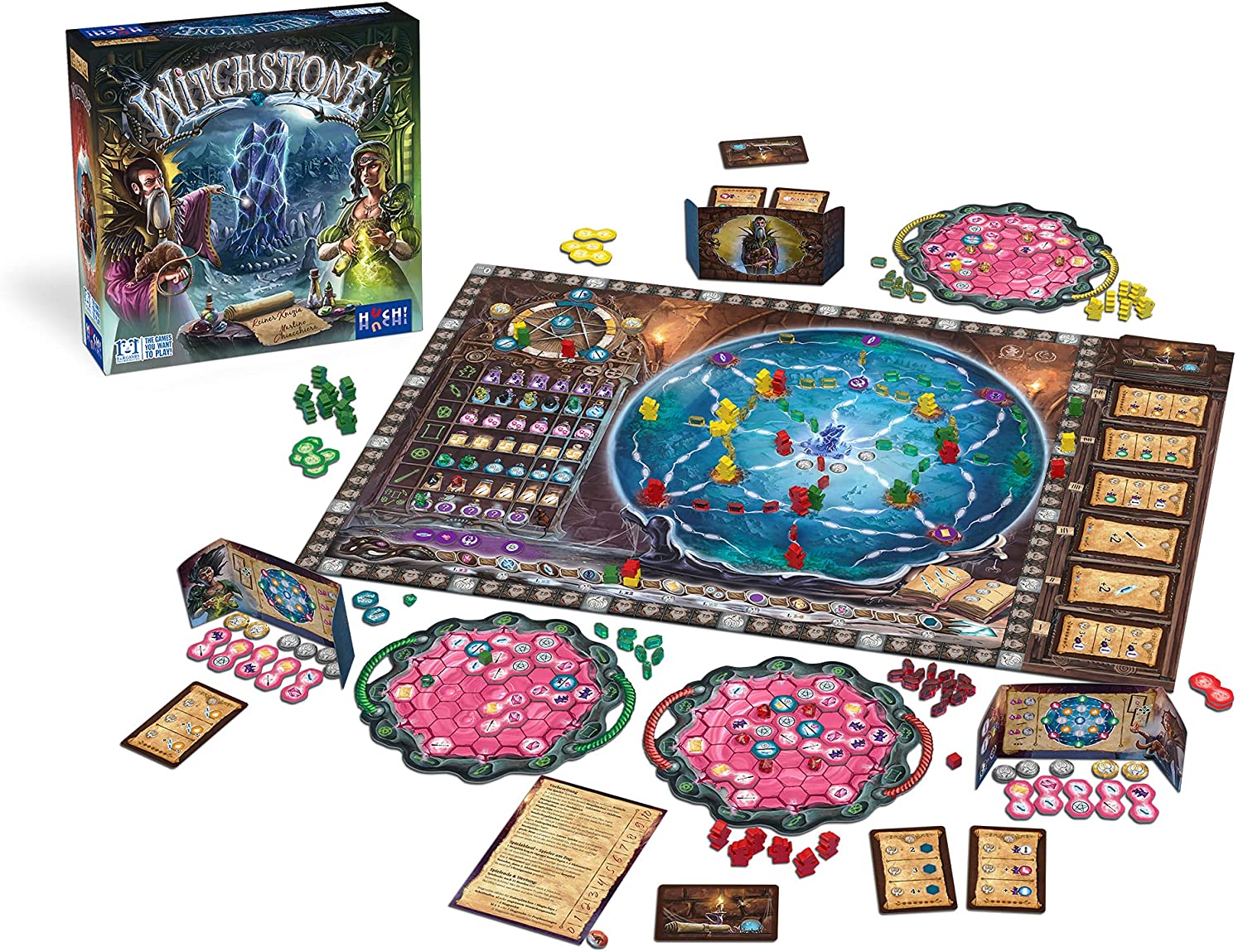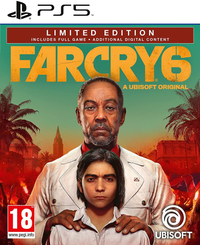Reiner Knizia is one of the most famous and prolific board game designers of all time. His work encompasses '90s classics like Ra and Modern Art, all the way to modern hits such as The Quest to El Dorado and My City. So when his name appears on a new game such as Witchstone, which he co-designed with Martino Chiacchiera, you sit up and take notice.
What’s in the Box
Beneath the big fold-out board lies a plethora of colorful components. There’s a selection of wooden witch and owl tokens and two different shapes of plastic crystal in each of the four player colors. Plastic can look cheap, and we know it is cheap, but cut gemstones can’t help but to retain a certain allure even when they’re not real.
The board itself adds to the visual theme by depicting a big crystal ball alongside other items of magical paraphernalia including a wand and a pentagram. There’s a deck of cards, too, although the art is functional and nowhere near as lavish as that on the box and board. Several sheets of cardboard sprue round out the components. These are serviceable enough and include a cauldron board for each player and a whole stack of tokens.
Rules and How to Play
Each turn in Witchstone starts with the player placing a tile from their hand into their cauldron. These tiles are double hexagons with a symbol on each end, and the two symbols indicate which actions you can take that turn. If you can place a symbol against a matching one already in your cauldron, you can take that action twice, or more if you’re increasing the size of a group of icons.
Right off the bat, this is a smart, shifting puzzle to enjoy. You’re caught three ways, between the tiles in your hand, the actions you want to take right now, and setting up symbol groups for the future. If you play this puzzle well, these groups can allow you to take large numbers of actions late in the game. Such big combo turns can often trigger further actions inside them, making them demanding, exciting and game-swinging all at the same time.
One such action is to migrate crystal tokens. These start in your cauldron and block tile placement spaces, so it’s good to get rid of them. If you can move them to the lip of the cauldron you’ll get one or two bonus actions depending on where, exactly, they end up. You also have a special black crystal at the centre of the cauldron which nets you double the effect if it reaches the edge.
This highlights two things about Witchstone. The first is the way in which all the mechanisms tend to cross over, as in the way crystals are bound up with your cauldron strategies. The second is that the rules are unintuitive, awkward and peppered with irritating exceptions.
You see, although Witchstone has all the trappings of a game about magic with its crystals, witches, and owls, it’s not actually about anything. It’s an abstract draped in a sorcerer’s cloak, an excuse to combine a wide range of play styles and mechanics. And while that marriage gives the game a lot of depth and variety, it means the rules don’t relate to any real-world activities and are hard to internalize.
Let’s explore some of the other actions to illustrate these points. Energy actions let you take possession of links between board spaces. These lean into witch actions that mean you can move your pieces onto the main board and move them around. First into particular spaces gain tokens that can be cashed in for bonus actions. Again, you see how the game interlinks its mechanisms and again there are various rules exceptions, which we won’t detail, to learn.
The next two mini-games are the pentagram and the magic wand. The pentagram action lets you move your token around the five points of that board symbol, gaining points or tokens. These can either be cashed in for bonus actions or placed in your cauldron to make bigger symbol groups. The wand is a race for bonus actions, as the first person to reach a given point on the wand track gets double the reward.
All of these action also have the potential to score you points, which is how you inch toward victory. Given the circular nature of how these various routes interlink, you might imagine Witchstone makes it hard to find a starting place to build a strategy. But it has a clever solution in its final action, the scroll, which lets you take a card from a face-up selection. Some of these give you action bonuses but others earn you substantial extra points for doing well at particular mini-games. These make an excellent starting point for your strategizing.
Between them, the effect of these disparate mini-games is to make Witchstone cross a number of genre boundaries. Pooling action combos in your cauldron feels a bit like an engine builder. Jostling for space on the crystal ball gives you a sense of area control. The wand and pentagram are races, where early leaders get bigger rewards. It’s a good mix, offering tidbits to lots of different tastes while retaining plenty of depth from the way the mechanisms interlock.
However, as the old saw goes, Jack of all trades is master of nothing. It’s satisfying to snatch a route away from another player but there’s nowhere near enough direct interaction to stop it being mostly a heads-down affair, for example. And without a unifying theme to tie the whole thing together, it can feel fragmented despite its smart overall design. This is especially true when the game runs long, as it will with more players, and while you’re still getting to grips with its mishmash of unintuitive rules.
The further you venture into the game, though, the more engaging it becomes. The rules become familiar and the increasing power of each of your turns spirals into some real excitement. Toward the end, when your cauldron tiles run out, you can be bagging big combos for huge point swings. Of course, so can all the other players, leading to lots of fun flip-flops over the lead as the game closes out.
Where to Buy
Source: https://www.ign.com/articles/witchstone-board-game-review
- Action
- activities
- All
- AREA
- around
- Art
- BAT
- Bit
- Black
- board
- bonus
- Bonuses
- Box
- build
- builder
- caught
- City
- components
- Crystal
- Design
- despite
- detail
- Early
- Edge
- energy
- engine
- First
- fun
- future
- game
- good
- Group
- How
- How To
- HTTPS
- huge
- Including
- interaction
- IT
- large
- Lavish
- lead
- leading
- LEARN
- Long
- Making
- Mechanics
- Modern
- move
- Near
- numbers
- offering
- Other
- plastic
- play
- player
- players
- Plenty
- possession
- potential
- power
- Puzzle
- quest
- Race
- range
- review
- Rewards
- Route
- rules
- Run
- sense
- setting
- Size
- smart
- So
- solution
- Space
- start
- Strategies
- Strategy
- The
- theme
- TIE
- time
- token
- Tokens
- track
- trades
- venture
- wand
- Work












